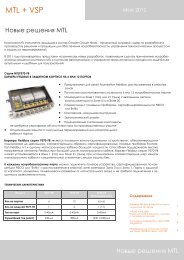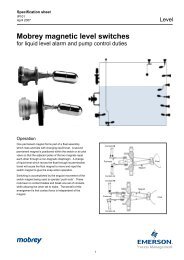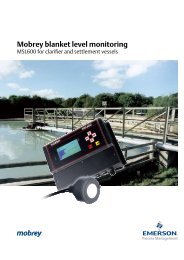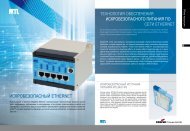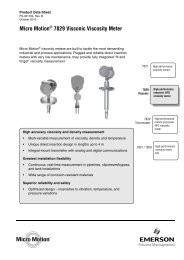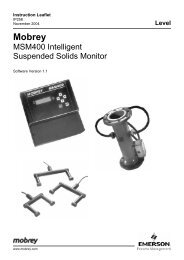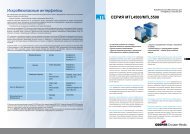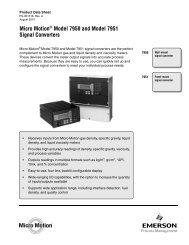You also want an ePaper? Increase the reach of your titles
YUMPU automatically turns print PDFs into web optimized ePapers that Google loves.
Bus interface modulesModbus protocol8505-BI-MB◆ links MTL<strong>8000</strong> node to Modbus host LAN◆ LAN speeds of up to 115.2 kbaud◆ supports up to 32 I/O modules◆ HART process and status variables via Modbus◆ module status & channel status flags◆ automatic scan optimisation◆ configuration data held in non-volatile memory◆ software configurable via local port or LAN B◆ HART ® maintenance via comms adaptorMODBUS SOFTWAREThe implementation of the Modbus protocol in the MTL<strong>8000</strong> Series isaccording to Revision G of the Modicon Specification. Only RTUmode is supported.Communication speeds of up to 115k baud are possible with singleLAN systems, 57k baud with twin connections. The LAN nodeaddress is set by configuration.The BIM supports the Modbus function codes that are required toread and write input, output and status data, and also supports anumber of special features which have been implemented to allowhigh integrity system operation and in-situ maintenance.DUAL LAN OPERATIONWhile LAN-A is the primary port for host communications, a secondhost may be connected to LAN-B as either an active or a passivestandby in a redundant configuration. This is intended to providefault tolerance against failure of either the primary host or itsassociated LAN connection.Active Standby mode is intended for use with a simple pair ofduplicated hosts.* Passive Standby mode is for a “redundant hostpair” where Host B is capable of detecting the failure of Host A orLAN-A and taking action to assume active control.A further mode of operation “Dual Comms” allows two hostssimultaneous read/write privileges. This is appropriate for manualcontrol via duplicate HMI/SCADA workstations.LAN-B may also be used for remote configuration andmaintenance of both an MTL<strong>8000</strong> sub-system and intelligent (HART)field devices connected to the I/O modules.DIAGNOSTIC AND STATUS INFORMATIONThe BIM provides detailed information relating to the status of theBIM, the health of I/O modules and the status of I/O channels.Depending on the I/O module type, information such as high andlow alarm, open circuit and line fault is reported.AUTOMATIC SCAN OPTIMISATIONThe gathering of input data from the I/O modules and the issuing ofoutput data to them is not determined by a fixed scan rate. A scanoptimisation algorithm is used to gather and distribute data virtuallyas soon as it becomes available. A maximum scan period can be setfor each module to ensure that the data is collected within thisdefined time period.PACKED DATA MAPPINGThe dynamic data that is exchanged with the host application ismapped to consecutive memory locations. This eliminates the needfor piecemeal read and write commands to separate data locations.A single Modbus read instruction will gather all of the current datafrom the BIM, resulting in a rapid interchange of information betweenthe node and the host. Writes to the BIM’s database can similarly bemade with a single command.HART DEVICE MAINTENANCEPass through messaging to HART devices is available via the localconfiguration port and the 8512 HART Comms interface. This allowsmulti-dropping of a number of BIMs on an RS485 link to a PCrunning AMS, Cornerstone TM and other instrument managementsoftware.BUILT-IN NON VOLATILE MEMORYThe BIM contains a section of non volatile memory (NVM) in whichthe configuration is stored. At switch on, the configuration is copiedfrom NVM into working memory and the BIM can then initialise itselftogether with the I/O modules.NODE SERVICES MODULE OPTIONThe BIM also supports the use of the 8510-MO-NS - Node ServicesModule - which can store a BIM’s configuration. This enables the BIMto be swapped with another and, at switch on, the configuration fromthe NSM will be uploaded to the BIM and will overwrite its previouscontents.In addition, the NSM will monitor the dc supplies that power thenode. If any power supply fail signal becomes active, the BIMreceives a fault signal; a particularly important feature for systemshaving redundant power supplies. The failed PSU can then beidentified quickly and replaced, restoring fault tolerant operation.AUTOCONFIGURATIONThe BIM has an autoconfiguration mode that can be triggered by asoftware command or by switches on the Node Services Module.This causes the BIM to delete its current configuration and reset themodules to their default values. The BIM then scans the Railbus andcreates a new configuration file based upon the module types fittedand using their default values, which is then saved to NVM.*In this mode of operation, writes to outputs are inhibited on the secondaryLAN during normal operation but enabled if the BIM detects failure of theprimary LAN.HART ® is a registered trademark of the HART Communications Foundation.Cornerstone TM is a trademark of Applied System TechnologiesEUROPE (EMEA) Tel: +44 (0)1582 723633 Fax: +44 (0)1582 422283AMERICAS Tel: +1 603 926 0090 Fax: +1 603 926 1899ASIA PACIFIC Tel: +65 487 7887 Fax: +65 487 7997E-mail: enquiry@mtl-inst.com Web site: www.mtl-inst.comJune 2004



